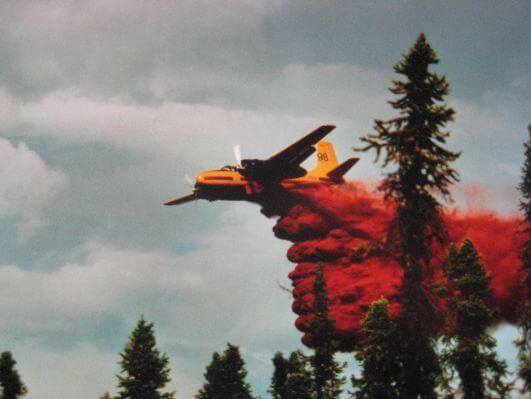Crew: 3
Capacity: Up to 1,400 kg of bombs during wartime, or 3,100 L of fire retardant in civilian guise
Length: 15m (50 ft)
Wingspan: 21 m (70 ft)
Height: 5. 64 m (18 ft 6 in)
Wing Area: 50 m sq (540 ft sq)
Weight: 10, 147 kg (22,370 lbs)
Loaded: 12,519 kg (27, 600 lbs)
Useful Load: 1,500 kg (3,330 lbs)
Powerplant: 2 × Pratt & Whitney R-2800-71 Double Wasp or -27s, or -79s 18-cylinder air-cooled two-row radial piston engines, 2,000 hp (1,500 kW)
Maximum Speed: 578 kmh (359 mph)
Range: 2,600 km (1,600 mi)
Service ceiling: 8,700 m (28,500 ft)
Yukon Companies: N/A
Yukon Pilots: N/A

World War 2 touched seemingly every place in the world in some way or an other, including the Yukon. The Douglas A-26/B-26, was originally designed to replace the A-20 “Havoc”. A-20 “Havoc”s were flown through Yukon on route to Russia, in part of the “Lend Lease” operation the USA was conducting with the Soviet Union. The A-26 would have to wait a little longer than its predecessor the A-20 to fly in Yukon airspace.
The “Invader” as it was known is an interesting aircraft in regard to Yukon Aviation. The A-26 has never lived in the Yukon permanently, but served it dutifully for nearly 30 years. What would a former combat aircraft have to provide the Yukon? Coincidentally the same powerful engines and bomb bay were put to excellent use in the wildfire suppression role. Operated under Air Spray of Edmonton Alberta, the A-26 would be the company´s primary wildfire suppression tool.
Air Spray would own and operate a total of 22 A-26 “Invaders”, using them as fast hard hitting air-tankers from 1970 until their eventual retirement in the early 2000s. Although capable of hauling 900 US gallons or 3,100 litres of fire retardant, government contracts required faster aircraft with larger capacity. The venerable workhorse had served its duty.
The A-26 with Air Spray served the Yukon Territory, the N.W.T., Alberta, British Columbia, and Saskatchewan for nearly 30 years. This is in addition to a plane that was nearly 30 years old by the time Air Spray began using them in 1970. It is safe to say that an aircraft designed to do damage to anything on the ground, ironically helped to stop the destruction caused by wildfires. Air Spray continues to operate in Yukon, using the larger L188 four engined turbo-prop Electra.
Yukon Transportation Museum does not own these photos, and is only using them to illustrate the history of these magnificent aircraft.

